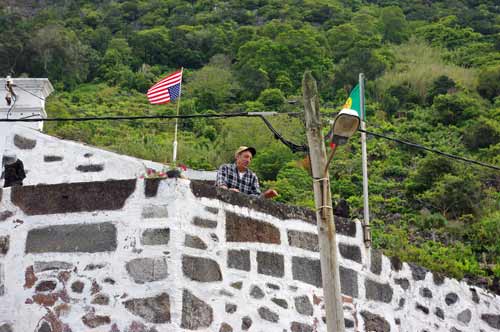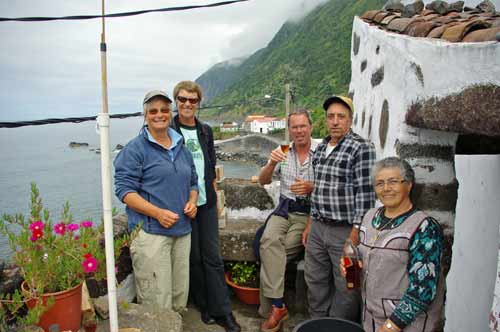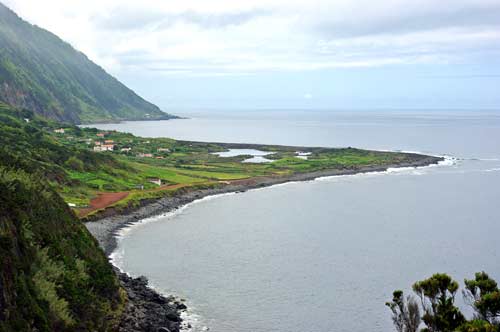Sao Jorge and on to Terceira

NORDLYS
David and Annette Ridout
Wed 27 May 2009 12:23
The Island of San
Jorge
38:43.8N
27:03.4W
Praia da Vitoria
Terceira
27th May 2009
I am writing this from the marina of Praia da
Vitoria which we entered yesterday afternoon after a lovely sail from Sao
Jorge. Leaving the little harbour of Vila das Velas we beat down between
Pico and Sao Jorge with full sail and 15 to 20 knots of breeze across
the deck. As we got out of the funnel effect between these two long high
islands the true wind came in from the SSE rather than the ESE so we were able
to ease sheets and reach across to Terceira. This we did with 10 to 12
knots across the deck and a smooth sea so a good speed was maintained in
sunshine. Just as the temperature dropped and the sun disappeared behind
the high ground of Terceira we entered the harbour. 68 miles in ten and a
half hours, little if any water on deck and only half an hour of engine as
the evening wind died. Gentleman's sailing.
However I am getting ahead of myself. This
all happened after a most enjoyable visit to the spectacular long high island of
Sao Jorge. Nearly 54 km long and 7.5 km wide nearly all the coast consists of
high cliffs and low tongues of lava or fajas as they are known.
It was these areas that were originally settled. Sao Jorge is seldom
without its long narrow cloud which keeps it moist without heavy rainfall.
Everything grows in abundance. It is the uplands however with their
rich grazing lands that provided the wealth of the island. Cattle
abound and have been raised here for over 500 years. The early
settlers actually lived on the fajas and kept their cattle on the
uplands. Much effort is being made in keeping the island
healthy. The low lying island of Topo on the eastern end was once used as
a pasture, the cattle being swum across, but is now a nature reserve.
Interestingly enough the dairy and stock rearing industries have been run for
decades using the most modern Danish co-operative methods with carefully bred
Holsteins, Shorthorn and Frisian herds. The island is famous for
its delicious, slightly sharp cheese.
We visited these uplands, also we descended
several times to the fajas and on one occasion to the
village of Sao Jorge which clings to the hillside beneath a cliff hundreds
of metres high. I have to confess that after 135 km of such driving I
was quite exhausted. We would not probably have come to this island if it
were not for a Dutchman and his wife who accosted us on the quayside of
Horta. The owners of a Swan 55 they also have a house on Sao Jorge where
they live for half the year. Their house is an old winery and
came with the requirement that they provide a cow every four years when the
island fiesta comes to their village. As Pieter said to me, 'one cow
every four years is not much property tax to pay'. It was a lucky meeting
as we much enjoyed this island and are likely to return, by air if not by
sea. In fact we feel that an air/ferry based trip to these islands is a
must. The idea of exploring them without any worries about weather would
be a pleasure. There are many small places to stay and the people are
quite fantastically friendly. Because of the small numbers perhaps
tourists are made very welcome as some of the following photos will
show.

Nordlys and Noa in the new small marina of
Velas. The biggest
snag of this harbour was that Cory
shearwaters use these cliffs
to roost and their cries at night were truly
awful.
Mid way between a very unhappy cat and a bird
being tortured the sound
produced by these roosting birds kept us awake
for hours.

As with Horta oodles of civic pride and decorated
pavements.

Walking through the village of Sao Jorge
which lies below towering
vegetation covered cliffs we were accosted
by this local from his balcony.
(no amount of persuasion would make him accept
that his American flag was
upside down!)

We were asked to taste their home made
wine. Sweet but surprisingly good.
They are the parents of 8 children, all of whom
are in the USA. Such
spontaneous friendliness is very typical we find.

Ilheu Topo, once a pasture now a nature
reserve. The skill of cobble design
is still very much in place as can be seen
from this new visitor viewing
place being constructed.

One of the most spectacular fajas.
Two such areas were separated by 4km
of track most of which we walked. up
and down it clung to the near vertical hillside.
Locals commute between the two villages by
quadbike. In years gone past it was by
donkey.
As I write this in Terceira Annette is busy
cleaning our home after a visit to the harbour master. The officials we
have found are without exception friendliness itself but the paperwork is not up
to modern EU standards but is rather a fall back to the old Portugese
ways. Long and tedious. Over the next few days we will
start the business of preparing for the last leg to the UK. Probably
either Falmouth or Plymouth. The weather charts show little signs of a
'weather window' so we will also explore locally after the chores are
done. The plan as I write is to make it back to Lymington on the 21st
June. We have been delighted to hear that our tenant is completing on a
house on the 23rd June and will leave ours on the 1st July. If all goes
according to plan it will be marvellous. Watch this space!!!
Happy times
David and
Annette
__________ Information from ESET NOD32 Antivirus, version of virus signature database 4108 (20090527) __________
The message was checked by ESET NOD32 Antivirus.
http://www.eset.com